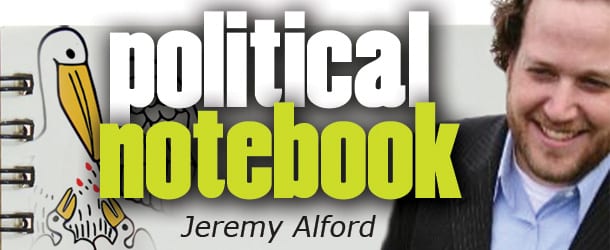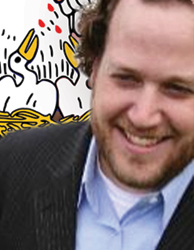State’s Fiscal Future Uncertain
The state’s new fiscal year started on July 1 with a budget that lawmakers and the Jindal Administration say is balanced. But Louisiana’s long-term financial outlook remains as murky as ever, as tax collections fail to impress, and an ongoing review by national credit rating agencies is nearing completion.
The state’s revenue — meaning incoming cash — is $7.1 billion year-to-date. This figure represents a 2 percent increase over the same period during the 2013-14 fiscal year.
While that’s a positive sign on paper, Treasurer John Kennedy said that the cash usually realized through severance taxes remains weak and there’s a noticeable downturn in corporate and franchise tax collections.
Looking further ahead, there have been administration forecasts that predict budget shortfalls of $1 billion or more annually through the 2018-19 fiscal year.
The Legislature and Jindal just addressed a $1.6 billion shortfall during the session that adjourned last month. Questions are still lingering in regard to the fixes — whether they’re permanent or whether they simply set up the state for another deficit after the next crop of state officials are elected in the fall.
The state was already tiptoeing around the major rating agencies before the session convened, and rightfully so. Tough questions were being asked about how the shortfall would be eliminated and the agencies wanted to know how structural deficiencies would be corrected.
Credit rating agencies have the authority to determine the state’s ability to pay back debt and make timely interest payments. Financially, they can sink a state with the stroke of a pen by making it more expensive for the state to borrow money.
Now that the session has been adjourned, the rating agencies are back, and Jindal, Kennedy and Commissioner of Administration Kristy Nichols have spent time in discussions with them over the past few weeks. “We had always intended, with the rating agencies, to come back together with them once the budget was complete,” said Nichols. “There were goals they wanted to see accomplished and we did that — like cutting one-time revenue sources down by half and creating recurring revenue.”
Kennedy said he was surprised that he wasn’t included in the very first calls with the administration and rating agencies. But he’s offered his own take on the session to the agencies since then. “I’m not going to talk about ‘the Louisiana miracle’ and all that,” the treasurer said before one such call. “I’m going to try to keep them from downgrading us. I think it’s a 50-50 shot.”
Citing temporary fixes for the most recently completed budget year and other concerns, Moody’s Investors Service and Standard and Poor’s Rating Services both reclassified the state’s status in February from “stable” to “negative.”
The state should learn over the next few weeks whether its credit rating is lowered as a result of the recent regular session and the administration’s budget practices. Depending on what happens, it could be an early sign of what’s to come as a new governor and Legislature are sworn in in January.
Commissioner May Run Again
After stints in the state House and Senate, Troy Hebert found himself in 2010 heading up the Office of Alcohol and Tobacco Control via an appointment by Jindal, who also tapped Hebert to serve as his legislative liaison this year.
But Hebert may not be done with elected office, he revealed during a recent interview in the Capitol’s Memorial Hall, in the shadow of the statue of Bienville, Louisiana’s relentless French period governor.
“Well, as commissioner of ATC I probably have one of the best appointed jobs in the state. I basically regulate fun for adults,” Hebert said laughing. “We have a lot of thirsty people in this state. Although I have to admit, I did enjoy my time as an elected official. Having won five-for-five, I may have one more race left in me.”
Nichols Unsure About Future
After nearly three years of serving as the point of Jindal’s spear on one controversial budget issue after another, Commissioner of Administration Kristy Nichols has built bridges and burned a few down in the Louisiana Legislature.
On the other hand, the role she’s filled usually leads to another high-profile position in government or the private sector — at least if recent history is any judge.
But with Jindal finishing up his final months in office, Nichols hasn’t yet revealed what her next move might be.
“I am hopeful that the level of loyalty and commitment that I have shown will help me find a right fit for where I’m headed,” she said. “I’ll be looking at both the private and public sectors for opportunities.”
Lawmakers have long been critical of her style. But a few did admit in interviews recently that they would want such an unwavering personality behind their own efforts if they were running the state.
“She uses her intelligence to be tenacious and that’s OK,” said Sen. Bret Allain, R-Franklin. “I know she rubs a lot of people the wrong way, and I don’t always agree with her, but she has always been open to talk to me and has always listened. She’s one of the smartest women I’ve ever met, and she’s dedicated to making the hard calls when she has to. That’s why she has the position she has.”
Coroner Recruited For Baton Rouge Mayor
Republican donors are urging East Baton Rouge Parish Coroner Dr. Beau Clark to run for mayor. But they’re unlikely to sway the up-and-coming politician.
“Since I became coroner, people have been encouraging me to look at the race, and it’s flattering,” Clark said. “I’m honored. But I ran for coroner with a certain set of goals, and I haven’t accomplished all of them. At this point I’m not interested, but I do not want to say no forever.”
Clark has made a splash on a number of issues by stepping outside of his normally quiet elected position and into the media and political spotlight. He grabbed headlines locally for revealing the staggering number of heroin deaths in the region and for calling for a review of related laws. This year, he’s had a hand in statewide policy in regard to sexual review examinations.
He previously served as medical director for the state House of Representatives and the Dept. of Health and Hospitals’ Bureau of Emergency Medical Services.
Political Polling At Crossroads
With cheap and fast automated surveys being dumped onto the election landscape in Louisiana, pollsters and consultants are taking stock and wondering what’s next. Fewer voters than ever are willing to participate in polls. More people are moving toward cell phone use only. Conflicting statistics have become the norm.
Reporters and editors, meanwhile, are fretting over what kind of numbers should be published for general consumption — and, more importantly, how they should be presented. Who paid for the poll? Are there any connections between the pollsters and the candidates or issues they’re polling? What’s the methodology? What’s the wording of the survey? These are just a few of the details that all too often go overlooked.
These uncertainties and questions are forming against the backdrop of a long-festering dust-up. On one side are traditional pollsters, who rely largely on surveys with live callers. On the other side are those new to the scene who only produce robo-polls, which are automated with recorded voices and touch-tone responses.
There’s an important trust factor at play here, especially when you consider how much polls can influence voter preferences, media coverage and fundraising. There’s probably no stopping the invasion of cheap polls into the Louisiana election conversation at this point. But perhaps we can all do a better job of interpreting them and weeding out the bad players.
It’s important to understand that methodology and sampling are at the core of this developing debate. Automated polling devices cannot place calls to cell phone users. Also, there’s no way to tell who’s on the receiving end of the calls, since the poll participants only have to push buttons to take part.
Live polling may have some of the same problems as well. But real voices carrying on a real dialogue help lessen the margins of error.
Nonetheless, there are serious challenges all the way around that pollsters big and small are facing. A decade ago just 6 percent of the U.S. population used cell phones only. Today, according to the National Health Interview Survey, that figure is closer to 43 percent, with an additional 17 percent mostly using cell phones. So any poll relying solely on cell phone users is cutting off a very large segment of the voting public, and the same goes for landline-only surveys.
In addition, voters are less likely to participate in a poll than ever before. The Pew Research Center found that caller ID and a general disinterest has driven down participation from 36 percent in 1997 to single digits today. To get 1,000 cell phone samples for a poll, the industry standard is to dial 20,000 phone numbers, the New York Times recently reported.
Even when a live sample is obtained from a cell phone user, it’s not always representative of the region being targeted. The area codes on cell phone numbers, as we all know by now, aren’t always specific to where the owner is registered to vote. It’s also difficult to know whether a “likely voter” is indeed likely to vote, which has long been a benchmark when one is determining the quality of a poll.
So what now? The best pollsters around are incorporating both landlines and cell phones into their models. That may be a factor to watch for, depending on what you want out of a poll. Automated robo-surveys do have value, but they seem to be cherished most by campaign managers and insiders who want a quick and dirty snapshot. To make important decisions, many would prefer a live poll or one that at least incorporates cell phones.
The bayou state hasn’t yet seen the same kind of embarrassing polling failures experienced elsewhere around the country in which the voting public serves up something dramatically different than the pollsters. But there have been shades of that in certain races and on particular issues.
For example, in the early spring of this year, the Public Policy Research Lab at LSU found that 44 percent of respondents felt the state was moving in the right direction with its policies and decisions, compared to 45 percent for wrong direction. It was a different showing than the findings produced by MarblePoint, a new automated firm working in Louisiana. That poll found 70 percent saying the state was going in the wrong direction and 30 percent in the right direction. The LSU poll used landlines and cell phones, and its numbers moved closer to MarblePoint’s when the landline results were isolated.
Looking ahead, the future may very well be computer-to-computer polling. But the matter is complex and plagued with many challenges. It may wind up being a mix of all of the methods discussed here.
Many argue polling as an industry is no more at a crossroads today than it was in 1948 when Gallup predicted Thomas E. Dewey would beat President Harry Truman. That may be true, but the past 67 years have certainly created a new set of challenges that could lead to unsavory results. No amount of polling can suggest otherwise as we move toward an era of data overkill with emerging pockets of public opinion uncertainty.














Comments are closed.